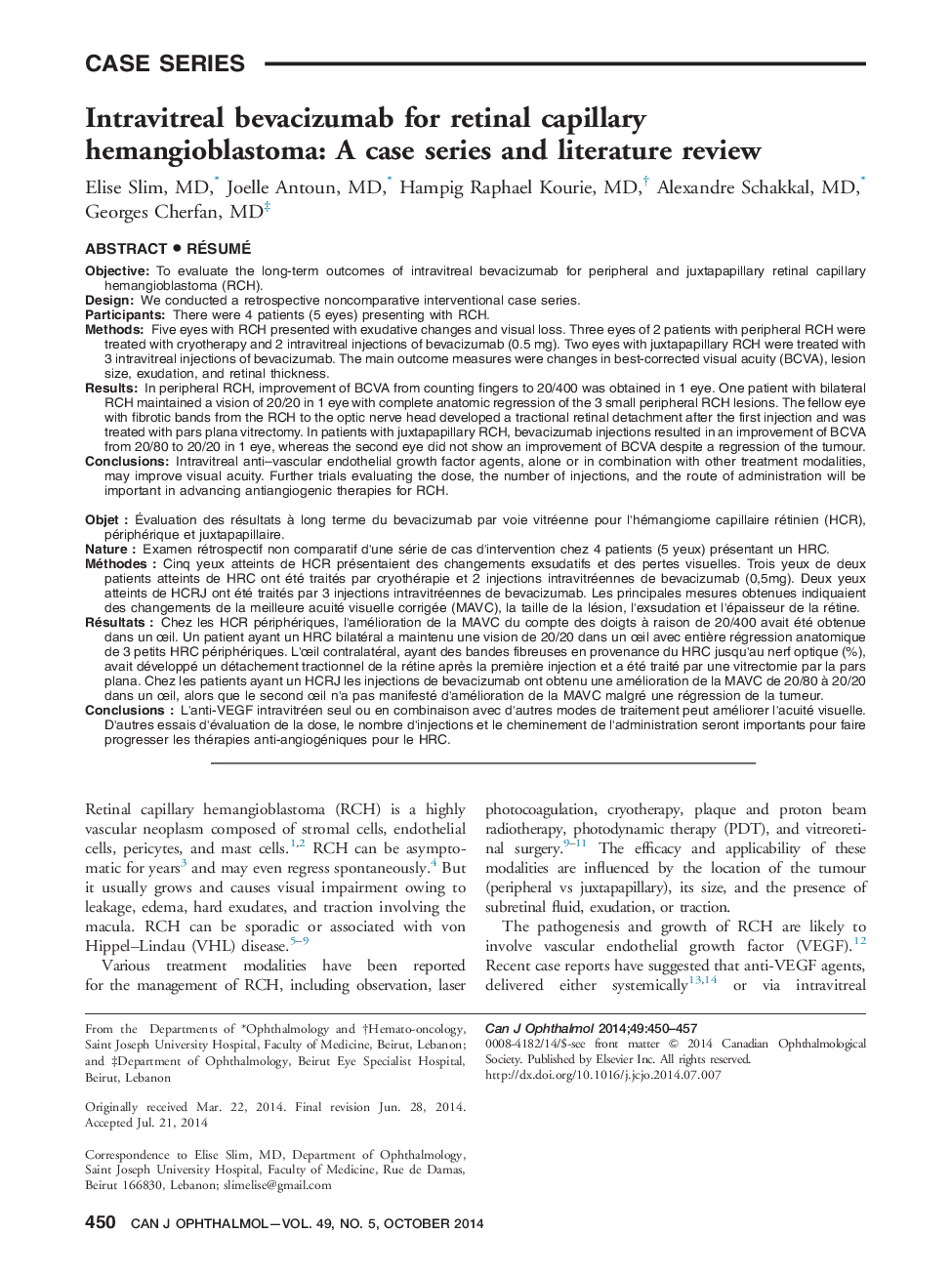| کد مقاله | کد نشریه | سال انتشار | مقاله انگلیسی | نسخه تمام متن |
|---|---|---|---|---|
| 4009191 | 1602401 | 2014 | 8 صفحه PDF | دانلود رایگان |

ObjectiveTo evaluate the long-term outcomes of intravitreal bevacizumab for peripheral and juxtapapillary retinal capillary hemangioblastoma (RCH).DesignWe conducted a retrospective noncomparative interventional case series.ParticipantsThere were 4 patients (5 eyes) presenting with RCH.MethodsFive eyes with RCH presented with exudative changes and visual loss. Three eyes of 2 patients with peripheral RCH were treated with cryotherapy and 2 intravitreal injections of bevacizumab (0.5 mg). Two eyes with juxtapapillary RCH were treated with 3 intravitreal injections of bevacizumab. The main outcome measures were changes in best-corrected visual acuity (BCVA), lesion size, exudation, and retinal thickness.ResultsIn peripheral RCH, improvement of BCVA from counting fingers to 20/400 was obtained in 1 eye. One patient with bilateral RCH maintained a vision of 20/20 in 1 eye with complete anatomic regression of the 3 small peripheral RCH lesions. The fellow eye with fibrotic bands from the RCH to the optic nerve head developed a tractional retinal detachment after the first injection and was treated with pars plana vitrectomy. In patients with juxtapapillary RCH, bevacizumab injections resulted in an improvement of BCVA from 20/80 to 20/20 in 1 eye, whereas the second eye did not show an improvement of BCVA despite a regression of the tumour.ConclusionsIntravitreal anti–vascular endothelial growth factor agents, alone or in combination with other treatment modalities, may improve visual acuity. Further trials evaluating the dose, the number of injections, and the route of administration will be important in advancing antiangiogenic therapies for RCH.
RésuméObjetÉvaluation des résultats à long terme du bevacizumab par voie vitréenne pour l'hémangiome capillaire rétinien (HCR), périphérique et juxtapapillaire.NatureExamen rétrospectif non comparatif d'une série de cas d'intervention chez 4 patients (5 yeux) présentant un HRC.MéthodesCinq yeux atteints de HCR présentaient des changements exsudatifs et des pertes visuelles. Trois yeux de deux patients atteints de HRC ont été traités par cryothérapie et 2 injections intravitréennes de bevacizumab (0,5mg). Deux yeux atteints de HCRJ ont été traités par 3 injections intravitréennes de bevacizumab. Les principales mesures obtenues indiquaient des changements de la meilleure acuité visuelle corrigée (MAVC), la taille de la lésion, l'exsudation et l'épaisseur de la rétine.RésultatsChez les HCR périphériques, l'amélioration de la MAVC du compte des doigts à raison de 20/400 avait été obtenue dans un œil. Un patient ayant un HRC bilatéral a maintenu une vision de 20/20 dans un œil avec entière régression anatomique de 3 petits HRC périphériques. L'œil contralatéral, ayant des bandes fibreuses en provenance du HRC jusqu'au nerf optique (%), avait développé un détachement tractionnel de la rétine après la première injection et a été traité par une vitrectomie par la pars plana. Chez les patients ayant un HCRJ les injections de bevacizumab ont obtenu une amélioration de la MAVC de 20/80 à 20/20 dans un œil, alors que le second œil n'a pas manifesté d'amélioration de la MAVC malgré une régression de la tumeur.ConclusionsL'anti-VEGF intravitréen seul ou en combinaison avec d'autres modes de traitement peut améliorer l'acuité visuelle. D'autres essais d'évaluation de la dose, le nombre d'injections et le cheminement de l'administration seront importants pour faire progresser les thérapies anti-angiogéniques pour le HRC.
Journal: Canadian Journal of Ophthalmology / Journal Canadien d'Ophtalmologie - Volume 49, Issue 5, October 2014, Pages 450–457